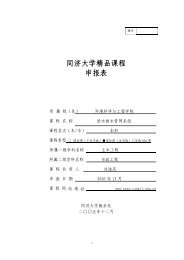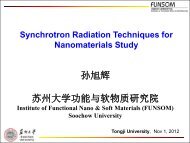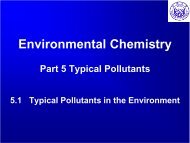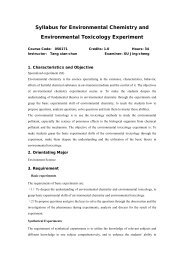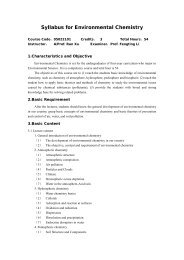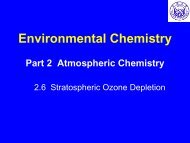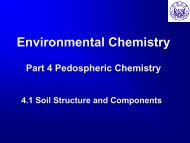PART 5_2 Chemical contaminants and ecotoxicology
PART 5_2 Chemical contaminants and ecotoxicology
PART 5_2 Chemical contaminants and ecotoxicology
Create successful ePaper yourself
Turn your PDF publications into a flip-book with our unique Google optimized e-Paper software.
Environmental Chemistry<br />
Part 5 Biospheric Chemistry<br />
5.2 <strong>Chemical</strong> <strong>contaminants</strong><br />
<strong>and</strong> <strong>ecotoxicology</strong>
Ecotoxicology<br />
• Ecotoxicological study is a multi-step<br />
process, involving:<br />
– The entry, distribution <strong>and</strong> fate of<br />
pollutants within the environment;<br />
– The entry <strong>and</strong> fate of pollutants in living<br />
(biota) organisms within an ecosystem;<br />
<strong>and</strong><br />
– The harmful effects of the chemical<br />
pollutants on the constituents (biotic &<br />
abiotic) of ecosystems (which include<br />
man).
Beyond our toxin trail<br />
Is the grave deeper than we thought<br />
Transport<br />
<strong>and</strong> fate<br />
Ingested<br />
Metabolized<br />
<strong>and</strong>/or stored<br />
Toxin<br />
emitted<br />
Ecosystem<br />
effects<br />
Contacts<br />
human<br />
Reaches<br />
an organ<br />
Community<br />
effects<br />
Population<br />
effects<br />
Physiological<br />
chain of events
Toxicology <strong>and</strong> Ecotoxicology are<br />
similar but not identical<br />
Toxicology<br />
• Absorption<br />
• Distribution<br />
• Metabolism<br />
• Elimination<br />
Ecotoxicology<br />
Release into environment<br />
Fate <strong>and</strong> disposition<br />
Metabolism<br />
No counterpart
There are also differences.<br />
Toxicology<br />
• Host defense<br />
mechanisms<br />
• Individual<br />
susceptibility states<br />
• Single effects<br />
• Cumulative<br />
exposure<br />
Ecotoxicology<br />
• Bioaccumulation<br />
• Bioconcentration<br />
(in water)<br />
• Biomagnification<br />
• Never single<br />
effects<br />
• Movement<br />
between media (air,<br />
water)
Ecological bases of Ecotoxicology<br />
• The basis for determining the effects of<br />
<strong>contaminants</strong> on ecosystem is at<br />
organism level<br />
• At organism level, response can be:<br />
– Acute toxicity causing mortality<br />
– Chronically accumulating damage ultimately<br />
causing death<br />
– Sublethal impairment of various aspects of<br />
physiology <strong>and</strong> morphology<br />
– Sublethal behavioral effects<br />
– Measurable biochemical changes
•At population level, response can be:<br />
–Size <strong>and</strong> dynamics (based on birth rates, death<br />
rates, gains, from immigration <strong>and</strong> losses from<br />
emigration)<br />
–Cause a reduction or an increase in the natural<br />
flowchart of numbers, in the biomass, sex ratio, etc.<br />
•At community level, response can be:<br />
–species diversity<br />
–predator prey relationship, etc<br />
•Change in ecosystem<br />
–nutrient cycling rates, patterns of nutrient flow,<br />
–physical-chemical conditions etc.
Underst<strong>and</strong>ing <strong>ecotoxicology</strong>
Assessment of Structural Changes<br />
changes in species / population structure<br />
- appearance/disappearance of an<br />
indicator species<br />
- number of individuals of a species<br />
- biomass of a species<br />
- presence or absence of a species<br />
Biomass-a quantitative estimate of the total mass of<br />
living plant or animal materials
changes in community/ecosystem structure<br />
- biomass<br />
- abundance<br />
- biotic indices (e.g. trophic types)<br />
- species richness / diversity<br />
- dominance<br />
- food chain length/complexity
<strong>Chemical</strong>s of Ecotoxicological<br />
interest<br />
• They are toxic <strong>and</strong> in many cases their<br />
metabolites are also harmful e.g. DDT & DDE<br />
(metabolite of DDT)<br />
• They are very stable both chemically <strong>and</strong><br />
environmentally<br />
• Their stability has lead to their persistence <strong>and</strong><br />
ubiquitous nature in the environment<br />
• Almost all chemicals of ecotoxicologigal interest<br />
are bioavailable <strong>and</strong> in most cases undergo<br />
bioaccumluation <strong>and</strong> biomagnification (food<br />
chain)
<strong>Chemical</strong> behavior <strong>and</strong> Bioavailability<br />
Bioconcentration (from external<br />
environment)<br />
Bioaccumulation (from external<br />
environment/food )<br />
Biomagnification (at higher tropic level)
Bioavailabiltiy The fraction of a chemical<br />
that is in an available form to an organism<br />
e.g. fish: food, absorption from water<br />
Bioconcentration - where the chemical<br />
concentration in an organism exceeds the<br />
concentration in the surrounding media (i.e.<br />
aquatic environment) as a result of exposure<br />
through the respiratory surfaces (i.e. gills/dermal<br />
surfaces) - not food!<br />
Bioconcentration Factor = conc. in organism<br />
conc. in ambient medium (usually water)
Bioaccumulation - where the chemical<br />
concentration in an organism achieves a level<br />
that exceeds that in the water/media as a result<br />
of chemical uptake through all routes of<br />
exposure.<br />
Bioaccumulation factor = Conc. in organism<br />
Conc. in food<br />
(or ingested water)<br />
•Bio-accumulation of Cd is higher than most<br />
metals as it is assimilated rapidly <strong>and</strong><br />
excreted slowly<br />
•depends on the rate of excretion
Biomagnification - where the chemical<br />
concentration in an organism achieves a<br />
level that exceeds that in the organism’s diet<br />
due to dietary absorption. i.e. higher trophic<br />
levels accumulate more chemical<br />
Biomagnification Factor =<br />
Conc. in predator<br />
Conc. in prey
Factors that influence bioaccumulation<br />
•Environmental persistence<br />
•Lipophilicity<br />
•Biotransformation
ECOSYSTEMS: Fate of Metals<br />
• The ultimate compartment is the whole<br />
planet but compartment can be<br />
– individual organism or<br />
– as small as single cells<br />
– Or even organelles within a cell<br />
• Metals are non-biodegradable<br />
• However there is the formation <strong>and</strong><br />
degradation of organometallic<br />
compounds e.g. MeHg,
Fate of Metals<br />
• Certain metals are assimilated by<br />
organisms to a greater extent than others<br />
• Bio-accumulation of Cd is higher than most<br />
metals as it is assimilated rapidly <strong>and</strong><br />
excreted slowly<br />
• Bio-availability is another reason for a high<br />
bio-concentration factor in that the<br />
chemical in question may be more bioavailable
Fate of Metals<br />
• pH is very important when it comes<br />
to metal bio-availability<br />
• Some metals e.g. Al is insoluble at<br />
normal to slightly acidic pH but<br />
below pH 4.5 its solubility increases<br />
dramatically <strong>and</strong> becomes most<br />
important responsible for fish kills<br />
in acidified lakes
ECOSYSTEMS: Terrestrial<br />
• Soils are contaminated<br />
– by metals <strong>and</strong> radioactive isotopes<br />
resulting from<br />
• industrial, mining or other activity or<br />
deposition from agricultural practices such<br />
as application of<br />
– metal-containing pesticides or<br />
– metal-contaminated sewage sludge<br />
– or wet or dry deposition from smelting<br />
activity, lead-containing car exhaust,<br />
atmospheric nuclear weapon testing or<br />
accidents such as Chernobyl.
ECOSYSTEMS: Terrestrial<br />
• Mobility of metals in soils is dictated<br />
largely by<br />
– clay content<br />
– amount of organic matter<br />
– pH<br />
• In general the higher the clay <strong>and</strong>/or<br />
organic matter content <strong>and</strong> pH, the more<br />
firmly bound are the metals <strong>and</strong> the longer<br />
is their residence time in soil<br />
• Acid rain helps in leaching nutrient<br />
(magnesium in European soil) from top to<br />
lower soil (inaccessible to root system)
ECOSYSTEMS: Terrestrial<br />
• Contamination of soils by radioactive<br />
materials is largely due to nuclear<br />
weapon testing (Australian <strong>and</strong><br />
Nevada deserts)<br />
• Accident has also contributed to that<br />
e.g. Chernobyl fallout outside the<br />
former Soviet Union.<br />
• When soils are contaminated<br />
organisms living in soils are affected
ECOSYSTEMS: Aquatic<br />
• The ultimate “sink” for metal is the ocean<br />
but difficult to estimate effect on biota due<br />
to massive dilution<br />
• Effect of metals on biota is much felt in<br />
estuaries especially those receiving water<br />
from contaminated sites<br />
• In estuaries the flow rate diminishes,<br />
suspended sediments settled <strong>and</strong> dissolved<br />
metals precipitated<br />
• Contaminated water affect organisms living<br />
in it
Biomarkers<br />
A xenobiotically induced alteration in<br />
cellular or biochemical components or<br />
processes, structures, or functions that is<br />
measurable in a biological system or<br />
sample.<br />
Types of Biomarkers<br />
Biomarkers of exposure<br />
Biomarkers of effect<br />
Biomarkers of susceptibility
1. Biomarkers of exposure<br />
Biomarkers of exposure include exogenous<br />
chemicals, metabolites, or products of<br />
interactions between environmental toxicants<br />
<strong>and</strong> target molecules or cells that are measured<br />
in a compartment within an organism (Travis,<br />
1993).
Internal dosimeters-<br />
1. measure the amount of a toxicant or its metabolite<br />
present in cells, tissues, or body fluids. Ex.<br />
urinary nitrophenol concentration used as a<br />
marker for methyl parathion exposure.<br />
2. account for individual differences in absorption<br />
<strong>and</strong> bioaccumulation of the xenobiotic <strong>and</strong> are<br />
relatively easy to measure.<br />
The biologically effective dose is the amount of the<br />
internal dose necessary to elicit a response or<br />
health effect.
2. Biomarkers of Effect<br />
Biomarkers of effect are measurable alterations<br />
of an organism that can indicate a potential or<br />
established health impairment or disease (Travis,<br />
1993). These can include an alteration in a tissue or<br />
organ, an early event in a biologic process that is<br />
predictive of disease, a health impairment or clinical<br />
disease, or a response parallel to the disease<br />
process, but correlated with it, <strong>and</strong> able to predict<br />
health impairment. Ex. the change in blood<br />
cholinesterase activity after exposure to anticholinesterase<br />
organophosphorous pesticides.
hypersensitivity)<br />
Nonspecific<br />
The induction of mixed function oxidase<br />
The formation of DNA adducts<br />
Sister chromatid exchange<br />
Str<strong>and</strong> breakage<br />
Porphyrin profile alteration<br />
Induction of vitellogenin in oviparous vertebrates<br />
Immunochanges (immunosupression,
Biomarkers in order of decreasing specificity<br />
Source: Walker et al. Principles of Ecotoxicology (2001) 2nd Edition [DUHS-P]
3. Biomarkers of Susceptibility<br />
Biomarkers of susceptibility indicate individual factors<br />
that can affect response to an environmental toxicant<br />
(Bearer, 1998). They are indicators of inherent or<br />
acquired properties of an organism that may lead to an<br />
increase or decrease in the internal dose of the<br />
xenobiotic or an increased or decreased level of the<br />
response resulting from the exposure.<br />
Genetic polymorphisms fall into this category of<br />
biomarkers.<br />
P450 1A1 induction<br />
Decreases in conjugated enzymes<br />
Inhibit the activity of immune system
Biomarker interpretation<br />
• Species different-ex.P450 induction<br />
• to integrate multiple chemical exposure across<br />
an area with a variety of chemical <strong>contaminants</strong><br />
•Relationship between biomarker <strong>and</strong> disease<br />
pathology<br />
•To predict disease<br />
•To predict environmental <strong>and</strong> genetic risk
Toxic Effects<br />
• The biochemical (molecular in nature) or<br />
physiological (observed at organ <strong>and</strong> whole<br />
organism levels) changes which adversely<br />
affect individual organisms’ birth, growth<br />
or mortality rates.<br />
• Both biochemical <strong>and</strong> physiological<br />
changes could lead to behavioral (whole<br />
organism level) changes
Example<br />
• The pollutant binding to a receptor<br />
• Followed by biochemical response at<br />
both cellular <strong>and</strong> organ levels<br />
• Leading to physiological responses<br />
• Finally, behavioral changes on the<br />
individual leading to effects on the<br />
population, community <strong>and</strong> the<br />
ecosystem.
BEHAVIORAL EFFECTS:<br />
– Migration,<br />
– intraspecific attraction,<br />
– aggregation,<br />
– aggression,<br />
– predation,<br />
– vulnerability,<br />
– mating
• Binding:<br />
– Reversible vs. Irreversible binding<br />
• Irreversible binding (covalent) causes harmful<br />
effects.<br />
• Types of bonding:<br />
– Covalent > ionic > Hydrogen binding > V<strong>and</strong>erwaals ><br />
hydrophilic<br />
• Biochemical responses:<br />
– Biochemical response could be protective or nonprotective<br />
(may or may not cause harmful effect).<br />
• Non-protective biochemical responses have<br />
Carcinogenic, Mutagenic, Teratogenic <strong>and</strong><br />
Neurotoxic potentials.
• Protective biochemical responses:<br />
– Monoxygenase (OCs <strong>and</strong> PAHs)<br />
– Induction <strong>and</strong> binding to metalothionein (Cu,<br />
Cd, Zn <strong>and</strong> Hg)<br />
– Binding to blood plasma, bones <strong>and</strong> hair<br />
(Metals <strong>and</strong> xenobiotics)<br />
– Dissolving in fat (organics- e.g. OCs)<br />
– Mineralization ( e.g. MeHg to Hg 2+)<br />
– Demineralization (As to MeAs)
Protective biochemical response<br />
• Heavy metals for example can be stored <strong>and</strong><br />
detoxified by organisms either by binding to<br />
specific proteins e.g. metallothioneins (-SH<br />
proteins)<br />
• In some cases it is mineralized to inorganic<br />
form, which is less toxic: e.g. Hg bound to Se<br />
is a mineralized Hg (detoxified Hg: MeHg to<br />
Hg). On the other h<strong>and</strong>, the inorganic form,<br />
which is more toxic can be methylated to a<br />
less toxic form e.g. As.
Protective biochemical response<br />
PHASE 1 REACTION.<br />
• Organic pollutants could also be metabolized <strong>and</strong><br />
detoxified by Cytochrome P450 enzymes<br />
(Microsomal Monoxygenase; MMO).<br />
PHASE 2 REACTION<br />
• The metabolites undergo conjugation with<br />
endogenous molecules e.g. GSH.<br />
• For some chemicals the metabolites/conjugated<br />
form are more toxic than the parent compound <strong>and</strong><br />
can lead to cancer formation.
Non-protective response<br />
– Binding to DNA (DNA adduct)<br />
– DNA Structural damage (str<strong>and</strong>s break)<br />
induced by genotoxic compounds<br />
– Binding to SH-Protein (Protein adduct);<br />
enzymes <strong>and</strong> proteins<br />
– Nerotoxicity: prolongation of K <strong>and</strong> Na flow<br />
<strong>and</strong> inhibition of AChE activity in the brain
Non-protective response<br />
– Mitochondrial Poison (lost of proton<br />
gradient)<br />
– Inhibition of vitamin K cycle (competition<br />
with vit K binding site)<br />
– Inhibition of Thyroxine (competition with<br />
thyrosine binding site)<br />
– Inhibition of ATPase (enzymes for<br />
transport of ions e.g. K, Na, Ca)
Non-protective response<br />
• Environmental Estrogens (eg DDT) <strong>and</strong><br />
<strong>and</strong>rogens (tributhyl Tin)<br />
• Endocrine disrupters (binding to endocrine<br />
receptors)<br />
• Photosystems of Plants (interruption of<br />
electron flow)<br />
• Plant growth regulation
Physiological changes<br />
Non-protective biochemical responses lead to<br />
Physiological changes which could be<br />
observed at organ <strong>and</strong> organism levels<br />
• Organ level:<br />
– accumulation of Cd in kidney, which could cause<br />
cell death (cytotoxicity), resulting in dysfunction of<br />
the kidney<br />
– PAHs <strong>and</strong> Lung cancer<br />
• Organism level:<br />
– decrease in production (growth <strong>and</strong> reproduction)<br />
– changes in gene frequency<br />
– decrease in resources acquisition <strong>and</strong> uptake
Behavioral Changes<br />
– Either or both physiological <strong>and</strong> biochemical<br />
effects could lead to behavioral effects at<br />
organism level-<br />
– e.g. caring for young ones <strong>and</strong> avoidance of<br />
predator.<br />
Biochemical, Physiological <strong>and</strong> Behavioral<br />
effects on the individual organism culminate<br />
effects observed at the Population,<br />
Community <strong>and</strong> Ecosystem levels.
Population Changes<br />
• Changes in population may come about as a<br />
result of direct changes in numbers of<br />
individual organism <strong>and</strong> gene frequency<br />
(resistance)<br />
• By indirect means (decrease in<br />
population of predators due to toxic<br />
chemicals could lead to increase in<br />
numbers of its prey).
Diclofenac residues as the cause of<br />
vulture population decline in Pakistan.<br />
Nature. 2004 Feb 12;427(6975):630-3.<br />
• Diclofenac<br />
causes kidney<br />
damage,<br />
increased serum<br />
uric acid<br />
concentrations,<br />
visceral gout, <strong>and</strong><br />
death.
• Changes in community structure<br />
– change in pyhtoplankton assemblage due to<br />
eutrophication<br />
– acid rain affecting microorganisms in the soil,<br />
aquatic life<br />
• Changes in Ecosystem level (earth as<br />
an ecosystem)<br />
– carbon dioxide increase<br />
– ozone depletion
Some General effects of pollution on an<br />
Ecosystem<br />
• Decrease in the suitability of the abiotic<br />
component as a habitat for the biotic<br />
components of the ecosystem, which have<br />
been naturally established <strong>and</strong> adapted to<br />
that ecosystem<br />
• Detrimental impact on part of the biotic<br />
component (vulnerable species) as related to<br />
the intensity <strong>and</strong> type of pollution<br />
• Alteration to the community structure <strong>and</strong> in<br />
most cases, there is a declined in the number<br />
of species present
Some General effects of pollution<br />
on an Ecosystem<br />
• Matter <strong>and</strong> Energy flow within the<br />
ecosystem changes<br />
• Removal of larger organisms with longer<br />
life spans<br />
• The appearance of opportunistic species<br />
with short life spans exhibiting large<br />
population fluctuations in time <strong>and</strong><br />
space
What is an Endocrine<br />
Disruptor <br />
“An exogenous agent that interferes<br />
with the synthesis, secretion,<br />
transport, binding, action, or<br />
elimination of natural hormones in<br />
the body that are responsible for the<br />
maintenance of homeostasis,<br />
reproduction, development <strong>and</strong>/or<br />
behavior. “
Mechanisms of endocrine disrupting<br />
compounds<br />
1) Binding <strong>and</strong> activating the estrogen receptor<br />
2) Binding but not activating the estrogen<br />
receptor (therefore acting as an anti-estrogen)<br />
3) Binding other receptors<br />
4) Modifying the metabolism of natural<br />
hormones<br />
5) Modifying the number of hormone receptors<br />
in a cell<br />
6) Modifying the production of natural hormones
Hormone regulation <strong>and</strong> feedback control<br />
Estrogen levels depend on<br />
Estrodiol serum-binding proteins<br />
α-fetoprotein (AFP)<br />
Testosterone-estradiol binding globulin<br />
Xenoestrogens (ex. DES)<br />
100-fold lower affinity than E2 to these binding<br />
protein<br />
Bioavailability increased
Non-genomic mechanisms of ED<br />
action<br />
• Compounds of the azole type, such as<br />
ketoconazole <strong>and</strong> the fungicide fenarimol,<br />
inhibit these CYP isoforms <strong>and</strong><br />
consequently can also affect steroid<br />
synthesis while the now-banned anti-fouling<br />
agent tributyltin <strong>and</strong> its metabolites, which<br />
have strong ED potential, are thought to act<br />
by the same mechanism, probably by<br />
inhibition of aromatase.
Genomic mechanisms of ED action<br />
• bind to oestrogen receptors <strong>and</strong> so act as<br />
pseudoestrogens in vivo, giving feminising effects<br />
• tamoxifen <strong>and</strong> diethylstilbestrol) <strong>and</strong> industrial<br />
chemicals (e.g. octylphenol <strong>and</strong> bisphenol-A<br />
• fungicide vinclozolin binds competitively to the<br />
<strong>and</strong>rogen receptor (Shono et al., 2004), blocking<br />
the cellular actions of testosterone on <strong>and</strong>rogendependent<br />
tissue growth <strong>and</strong> behaviour patterns<br />
• chlordecone, inhibit binding to the oestrogen <strong>and</strong><br />
progesterone receptors (Guzelia, 1982), whereas<br />
bisphenol-A can block lig<strong>and</strong> binding to the thyroid<br />
receptor
Timing, duration, <strong>and</strong> amount of exposure.<br />
Organization vs. activation<br />
Timing, duration, <strong>and</strong> amount of exposure are each<br />
important determinants of the outcome. There are<br />
windows of vulnerability during fetal development in<br />
which small exposures to endocrine disruptors may<br />
have profound effects not observed in adults.<br />
Studies of the intrauterine position of mice during<br />
fetal development show that slight fluctuations of<br />
steroid hormone levels influence genital morphology,<br />
timing of puberty, sexual attractiveness, sexual<br />
behavior, aggressiveness, <strong>and</strong> activity level of<br />
offspring.
Various Classes of EDCs<br />
Flame Retardants<br />
Fungicides<br />
Herbicides<br />
Insecticides<br />
Metals<br />
Pharmaceuticals<br />
Phenols<br />
Plasticizers<br />
Polyaromatic<br />
Hydrocarbons<br />
Soy Products<br />
Surfactants<br />
Polybrominated diphenyl ether<br />
Vinclozolin<br />
Atrazine<br />
Methoxychlor<br />
Tributyltin<br />
Ethynyl Estradiol<br />
Bisphenol A<br />
Phthalates<br />
PCBs, dioxins<br />
Genistein<br />
Alkylphenol<br />
Ethoxylates
PBDEs( 多 溴 二 苯 基 醚 )<br />
• Polybrominated diphenyl ethers (PBDEs)<br />
are a class of recalcitrant <strong>and</strong><br />
bioaccumulative halogenated<br />
compounds that have emerged as a<br />
major environmental pollutant. PBDEs<br />
are used as a flame-retardant <strong>and</strong> are<br />
found in consumer goods such as<br />
electrical equipment, construction<br />
materials, coatings, textiles <strong>and</strong><br />
polyurethane foam (furniture padding).
Bioavailability of PBDEs<br />
‣Found in animals<br />
‣Increase in fish<br />
‣Increase in whales<br />
‣Sewage sludge<br />
‣PCBs Found in Lake Washington<br />
Fish (PBDEs next)<br />
‣Found in human (breast milk)
PBDEs Breast Milk - Sweden<br />
(Norén <strong>and</strong> Mieronyté, 1998)
Health Effects of PBDEs<br />
‣Similar to PCBs (Polychlorinated biphenyls)<br />
‣PBT (Persistent Bioaccumulative Toxicant)<br />
‣No human data<br />
‣Animals studies indicate<br />
‣Effects thyroid hormone levels<br />
‣Neurobehavioral toxicity<br />
‣Effects development - alters Behavior<br />
‣Impairs memory <strong>and</strong> learning<br />
‣Delays sexual development
Vinclozolin<br />
• Vinclozolin is a fungicide that has been<br />
shown to cause Leydig cell tumors <strong>and</strong><br />
atrophy of the accessory sex gl<strong>and</strong>s in<br />
adult rodents. In addition, exposure of<br />
rats during pregnancy causes a pattern<br />
of malformations in the male urogenital<br />
tract .<br />
• Androgen receptor antagonist
Atrazine<br />
• A chlorotriazine herbicide, is used to control<br />
annual grasses <strong>and</strong> broadleaf weeds.<br />
• suppression of the luteinizing hormone surge<br />
during the estrus cycle by atrazine leads to the<br />
maintenance of elevated blood levels of 17betaestradiol<br />
(E2) <strong>and</strong> prolactin.<br />
• The mechanism for tumor development may<br />
include one or more of the following: the induction<br />
of aromatase (CYP19) <strong>and</strong>/or other P450<br />
oxygenases, an antagonist action at the estrogen<br />
feedback receptor in the hypothalamus, an<br />
agonist action at the mammary gl<strong>and</strong> estrogen<br />
receptor or an effect on adrenergic neurons in the<br />
hypothalamic-pituitary pathway.
双 酚 A<br />
Bisphenol-A<br />
BPA is used in the manufacture of<br />
polycarbonate plastics <strong>and</strong> epoxy resins from<br />
which food <strong>and</strong> beverage containers <strong>and</strong> dental<br />
materials are made. Perinatal exposure to<br />
environmentally relevant BPA doses results in<br />
morphological <strong>and</strong> functional alterations of the<br />
male <strong>and</strong> female genital tract <strong>and</strong> mammary<br />
gl<strong>and</strong>s that may predispose the tissue to earlier<br />
onset of disease, reduced fertility <strong>and</strong> mammary<br />
<strong>and</strong> prostate cancer
聚 氯 乙 烯 (PVC)<br />
让 长 牙 的 婴 儿 咬 玩 得 固 齿 器 、 洗 澡 玩 得 软 性 玩 具 、 价 格 不 贵 的 流<br />
行 卡 通 玩 具 常 常 是 PVC 制 品 , 在 使 用 中 可 能 释 放 出 邻 苯 二 甲 酸<br />
(phthalates) 这 类 有 致 癌 性 的 环 境 荷 尔 蒙 。<br />
【 安 全 替 代 品 】 仔 细 查 看 成 分 标 示 , 凡 是 婴 幼 儿 可 能 放 在 口 中 把<br />
玩 的 玩 具 一 定 选 择 PE( 聚 乙 烯 ) 制 品 。<br />
苯 乙 烯 alkylphenol ( 烷 基 酚 )<br />
摊 贩 、 自 助 餐 店 、 速 食 店 的 热 饮 杯 ( 装 汤 、 茶 、 咖 啡 )、 方 便<br />
面 的 面 碗 及 面 杯 绝 大 多 数 都 是 使 用 聚 苯 乙 烯 (polystyren) 的 塑<br />
胶 容 器 , 简 称 PS。 其 原 料 单 体 叫 苯 乙 烯 , 是 已 知 致 癌 物 。 并 且<br />
制 造 过 程 所 添 加 的 增 塑 剂 alkylphenol( 烷 基 酚 ) 也 是 会 干 扰 内<br />
分 泌 的 环 境 荷 尔 蒙 , 二 者 在 使 用 过 程 中 很 容 易 溶 出 到 食 物 中 。
化 妆 品 中 的 环 境 荷 尔 蒙<br />
多 数 的 化 妆 品 、 卸 妆 用 清 洁 用 品 含 有 几 类 的 环 境<br />
荷 尔 蒙 :<br />
• 壬 基 苯 酚 乙 烯 ( 一 种 非 离 子 表 面 活 性 剂 )<br />
• 邻 苯 二 甲 酸 (phthalates)<br />
• 烷 基 酚 (alkylphenol)
Tributyltin (TBT)<br />
三 丁 基 锡 是 一 种 有 机 锡 化 合 物 ,<br />
常 被 添 加 于 船 舶 油 漆 中 , 以 防 止 贝 类<br />
及 藻 类 附 着 于 船 身 , 由 于 具 有 杀 菌 效<br />
果 , 所 以 也 可 以 作 为 杀 菌 剂 使 用 。
收 到 三 丁 基 锡 或 三 苯 基 锡 污 染 的 雌 岩 螺 , 因 生 殖 孔 阻 塞 受<br />
精 卵 无 法 排 出 , 堆 积 在 生 殖 管 道 内 变 红 变 黑 形 成 坏 死 组 织 ,<br />
此 时 长 出 阴 茎 的 雌 化 作 用 也 同 时 引 发 。
许 多 生 物 对 有 机 锡 的 代 谢 能 力 低 , 在 低 浓<br />
度 长 时 间 的 污 染 下 , 负 面 效 果 即 能 呈 现 , 有 机<br />
锡 累 积 在 食 物 链 顶 端 的 鲸 豚 肝 脏 也 普 遍 存 在<br />
(up to 10 mg/kg)。 鉴 于 有 机 锡 污 染 对 海 域 生<br />
态 的 威 胁 , 全 世 界 将 禁 止 三 丁 基 锡 作 为 油 漆 添<br />
加 物 。<br />
此 外 , 有 机 锡 还 有 致 畸 胎 作 用 。
Phthalates 邻 苯 二 甲 酸 酯<br />
• 软 化 剂 , 广 泛 存 在 于 化 妆 品 、 儿 童 玩 具<br />
和 食 品 包 装 袋 中<br />
• 聚 氯 乙 烯 PVC 制 品 在 使 用 中 可 释 放 出 邻<br />
苯 二 甲 酸 酯<br />
• male infertility<br />
• Interfere with cholesterol uptake <strong>and</strong><br />
<strong>and</strong>rogen biosynthesis
Alkylphenol( 烷 基 酚 )<br />
• 聚 苯 乙 烯 制 品 制 造 过 程 中 所 添 加 的 增 塑 剂<br />
alkylphenol( 烷 基 酚 ) 也 是 会 干 扰 内 分 泌 的 环<br />
境 荷 尔 蒙 disrupted reproduction in pikeperch<br />
• In juvenile fish a decrease in the percentage<br />
of males <strong>and</strong> an increase of intersex fish was<br />
observed in relation to dose of NP <strong>and</strong> time of<br />
exposure to this alkylphenol.<br />
• Exposure of adult males to the NP led to the<br />
reduction in fecundity, milt quality <strong>and</strong> fertility.
EDSTAC Tier 1 Assays<br />
Concerned with detecting<br />
• Receptor binding assays (ER <strong>and</strong> AhR)<br />
• Uterotrophic<br />
• Hershberger<br />
• Pubertal female<br />
• Steroidogenesis<br />
• Frog metamorphosis<br />
• Fish reproductive screen
EDSTAC Tier 2<br />
dose-response relationship<br />
• Mammal development <strong>and</strong><br />
reproduction<br />
• Bird development <strong>and</strong> reproduction<br />
• Mysid shrimp life cycle<br />
• Fish reproduction <strong>and</strong> development<br />
• Amphibian development <strong>and</strong><br />
reproduction
Species-dependent sex determination<br />
Mammal XY/XX<br />
synthesis of testosterone/functional <strong>and</strong>rogen receptors<br />
estrogen receptor in the brain<br />
Birds WZ/WW<br />
The ability to synthesize <strong>and</strong> recognize 17β-estradiol is<br />
necessary for female CNS <strong>and</strong> gonadal sexual<br />
development to occur<br />
Reptile<br />
temperature-dependent sex determination (aromatase<br />
related)
Temperature-dependent sex determination<br />
thermosensitive period (TSP)
Temperature<br />
determines their<br />
sex. A nest<br />
temperature of<br />
73.5 degrees<br />
would develop<br />
males. If it heats<br />
up to 83.5,<br />
hormones would<br />
trigger changes<br />
causing the<br />
embryonic cells<br />
to differentiate<br />
as females.
III. Field studies<br />
Manipulative<br />
Observational (biomonitoring)<br />
This sections looks briefly at the field of microcosm<br />
<strong>and</strong> mesocosm toxicity testing.<br />
Microcosms - laboratory systems that are<br />
intended to physically simulate an ecosystem or a<br />
major subsystem of an ecosystem. They are an<br />
attempt to create systems that display ecosystem<br />
properties while permitting control of conditions <strong>and</strong><br />
replication of treatments at reasonable cost.
There are two types of microcosms, assembled <strong>and</strong><br />
excised.<br />
One of the more common assembled type is the aqutic<br />
microcosm developed by Taub (see Suter, 1993). This<br />
system consists of ten species of algae, five<br />
zooplankters (cladoceran, amphipod, ostracod,<br />
protozoan, <strong>and</strong> rotifer), <strong>and</strong> a bacterium in a defined<br />
aqueous medium with serile s<strong>and</strong> sediment all contained<br />
in gallon jar under fluorescent lights. The advantage of<br />
the system is that it is st<strong>and</strong>ardized, similar results can<br />
be achieved from different labs, researchers can<br />
compare results with different chemicals, <strong>and</strong> the limited<br />
<strong>and</strong> constant array of species makes it more likely that<br />
the cause of observed responses can be determined<br />
making it possible to model the ecosystem level<br />
interactions for extrapolation to the field. However, they<br />
are very much oversimplified.
Excised microcosms are segments of ecosystems that<br />
have been removed from the environment as a unit or a<br />
few units <strong>and</strong> placed in containers in the laboratory.<br />
They contain natural assemblages of biota, natural<br />
median <strong>and</strong> are more realistic. The are also less<br />
amenable to quality control <strong>and</strong> to comparisons.<br />
Examples include:<br />
•Mixed flask culture - mixed culture of microbes <strong>and</strong><br />
microinvertebrates derived from one or more natural<br />
communities <strong>and</strong> held in the lab.<br />
•Pond microcosm - water, sediment, macrophytes, <strong>and</strong><br />
associated biota obtained from a shallow pond or the<br />
littoral zone of a lake or slow-moving river<br />
•Site-specific aquatic microcosm - large tank of<br />
ambient water, a sediment core suspended in the water,<br />
<strong>and</strong> associated biota
Mesocosms - outdoor experimental systems that are<br />
delimited <strong>and</strong> to some extent enclosed.<br />
These systems offer more realism than microcosms due<br />
to their larger size <strong>and</strong> more natural physical conditions<br />
but can still provide replication, control of chemical<br />
exposure, <strong>and</strong> some control of biotic components.<br />
Mesocosm studies are currently a requirement for<br />
pesticide registration in the U.S. Mesocosms are also<br />
either assembled such as artificial ponds <strong>and</strong> streams or<br />
delimited such as limnocorrals <strong>and</strong> other enclosures of<br />
portions of an ecosystem.
Biomonitoring
生 物 監 測 (Biomonitoring) 在 歐 洲 國 家 於 20 世 紀<br />
初 首 先 使 用 藻 類 腐 水 指 標 系 統 監 測 水 質 , 其 後 陸 續<br />
建 立 底 棲 生 物 及 魚 類 指 標 監 測 方 法 。 一 般 河 川 水 質<br />
監 測 只 有 分 析 水 中 理 化 參 數 , 而 忽 略 水 中 生 物 之 存<br />
在 與 否 。Loeb 及 Spacie(1994) 指 出 , 水 中 生 物<br />
因 長 期 生 活 棲 息 之 水 中 環 境 , 任 何 外 來 物 質 刺 激<br />
(Stress), 他 們 首 當 其 衝 , 故 他 們 才 是 最 佳 環 境<br />
監 測 器 。 他 們 身 體 健 康 情 況 或 存 在 與 否 , 即 是 反 映<br />
水 質 好 壞 。<br />
河 川 生 物 監 測<br />
藻 類 評 估 水 質 使 用 之 方 法 為 藻 屬 指 數<br />
底 棲 水 生 昆 蟲 使 用 之 方 法 為 科 級 生 物 指 標 及 快 速 生<br />
物 評 估 法<br />
魚 類 評 估 方 法 有 魚 類 生 物 整 合 性 指 標 法 及 魚 類 指 標<br />
法
An Index of Biotic Integrity (IBI) is a tool (index) which<br />
we use to determine the health (integrity) of the fish<br />
community (biotic) in a given river. Webster's defines<br />
an index as "a ratio or other number derived from a<br />
series of observations <strong>and</strong> used as an indicator or<br />
measure". Biotic is defined as "of or relating to<br />
life". And integrity is defined as "the quality or state of<br />
completeness".<br />
The IBI examines three components of the fish<br />
community to determine its health. By knowing the<br />
abundance (total number of fish), the diversity<br />
(number of different species), <strong>and</strong> trophic (food chain)<br />
interactions, we get an idea of how healthy the fish<br />
community is in a given area.
Indicator species<br />
A species whose status provides information<br />
on the overall condition of the ecosystem <strong>and</strong><br />
of other species in that ecosystem.<br />
Particular tolerant or sensitive to<br />
environmental contamination.<br />
Ex. Ephemeroptera, Plecoptera, <strong>and</strong><br />
Trichoptera<br />
Biomarker responses to specific chemical<br />
are well characterized<br />
Accumulated environmental <strong>contaminants</strong>
Example 1<br />
• What will happen When Raw Domestic<br />
Sewage from a Sewered Community of<br />
40,000 people flows into a stream
Ecological Risk Assessment<br />
has three primary phases<br />
Problem formulation<br />
Analysis<br />
Risk characterization
•Data required to conduct an ecological risk<br />
assessment include the following:<br />
•Toxicity to wildlife, aquatic organisms, plants, an<br />
nontarget insects<br />
•Environmental fate<br />
•Environmental transport<br />
•Estimated environmental concentrations<br />
•Where <strong>and</strong> how the pesticide will be used<br />
•What animals <strong>and</strong> plants will be exposed<br />
•Climatologic, meterologic, <strong>and</strong> soil information



